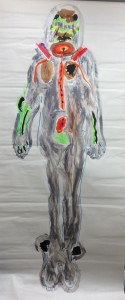In today’s world, an inordinate number of people hold and carry tremendous stress, not only in the mind, but also the body. This stress can exacerbate other problems such as temper, chronic pain, or a sharp, critical tongue. For an addict, untreated excessive stress can be the harbinger of relapse.
I use a life-sized silhouette mandala (body map) to help people process where and how stress presents somatically.
For new clients, I might ask them to rank stress according to the colors of a flame. For the purpose of this exercise, red equals the lowest level of heat, and blue the hottest.
I ask questions about where stress presents first, second, and so on. I ask about the quality and texture of stress or body pain. I ask clients to add other categories of stress beyond the prescribed colors I have suggested. In other words, I want the process to be as personal and as descriptive as possible.
Because of the unique and idiosyncratic nature of symbols, each person creates a personal legend of symbols and meaning as a guide.
Generally, people gain insight such as, “I never knew this,” about myself. Others determine at what point they need to stop, take notice, and intervene before a larger problem emerges.
There are people who can wait until the subjective ranking of stress has become the level yellow before a personal intervention, just before the hottest color blue. Others must intervene much more quickly in the process, maybe even at the first glimpse or hint of embodied stress – level red.
At the point of intervention, where ever that falls, self-soothing techniques are applied.
I have been a witness to how this technique has helped people gain control of an alleged, “hair trigger,” temper, or helped prevent relapse, and/or reduce pain.
The creative arts therapies help people bypass cognitive defenses and touch the center of an issue; it is a process that is elegant, sophisticated, and fun.

